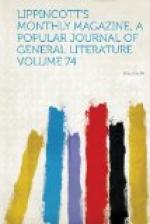[Illustration: SWEDISH SCHOOL-HOUSE.]
His fiscal affairs brought into comfortable shape, the tourist from abroad may be desirous of seeing more of the United States than is included in the view from the great Observatory. The landscape visible from that point, as he will find after being wound to the top by steam, is not flecked with buffaloes or even the smoke of the infrequent wigwam, as the incautious reader of some Transatlantic books of travel might expect. For the due exploration of at least a portion of the broad territory that lies inside of the buffalo range he needs a railway-ticket and information. These are at his command in the “World’s Ticket and Inquiry Office,” the abundantly comprehensive name of a building near the north-east corner of Machinery Hall. In a central area sixty feet in diameter tickets to every known point are offered to him by polyglot clerks. Here, too, a wholesome interchange of ideas in regard to the merits of the various traveling regulations of different countries may be expected. Baggage-checks or none, compartment or saloon cars, ventilation or swelter in summer, freezing or hot-water-pipes in winter, and other like differences of practice will come under consideration with travelers in general council assembled. Give and take will prevail between our voyagers and railway officials and those of the Old World. Both sides may teach and learn. Should the carriage of goods instead of persons be in question, the American side of the materials for its discussion will be found in the building of the Empire Transportation Company, where the economies of system and “plant,” which have for a series of years been steadily reducing the expenses of railway-traffic until the cost of carrying a ton one mile now falls within one cent, will be fully detailed. A further reduction of this charge may result from the exposition if exhibitors from Europe succeed in explaining to our engineers and machinists how they manage to lighten their cars, and thereby avoid carrying the excess of dead weight which contributes so much to the annihilation of our tracks and dividends.
[Illustration: SPANISH BUILDING.]




